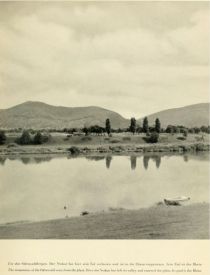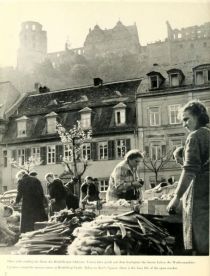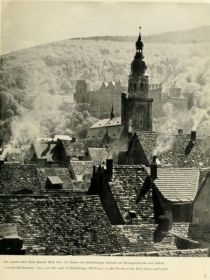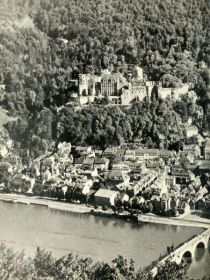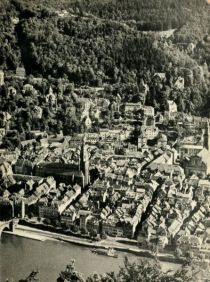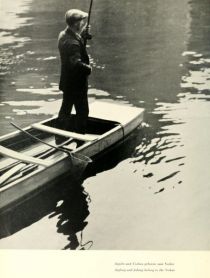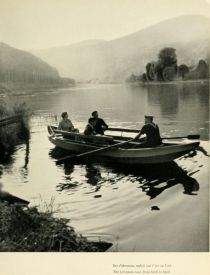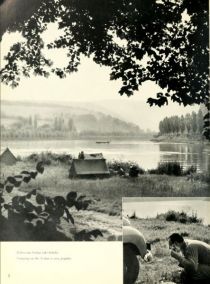The Neckar Valley. From Heidelberg to Wimpfen
Picture of a well-loved landscape.
Autor: Rudolf und Gisela Schuler, Max Perkow, Horst Lemke, Claire Heineke, Erscheinungsjahr: 1900
Exemplar in der Bibliothek ansehen/leihen
Exemplar in der Bibliothek ansehen/leihen
Themenbereiche
Enthaltene Themen: Neckarta, Neckar Valley, Heidelberg, Neckar, Wimpfen, Hornberg, Reisen, Reisebeschreibung, Hirschhorn, Eberbach, Guttenberg, Stolzeneck, Zwingenburg, Minneburg,
64 Pages of Photographs by Rudolf Schuler
Introductory words by Max Perkow
With drawings by Horst Lemke
Translated by Claire Heineke
Title and cover Gisela Schuler
****************************
Introductory words by Max Perkow
With drawings by Horst Lemke
Translated by Claire Heineke
Title and cover Gisela Schuler
****************************
Inhaltsverzeichnis
Heidelberg gateway to the Neckar Valley
The praises of the Neckar Valley have been sung from times immemorial. Its beauty is not of the kind to which one easily becomes accustomed and therefore soon no longer sees. On the contrary, the charm of the Neckar Valley will always delight those who are familiar with it. Could anyone living within reach ever grow tired of the picture presented to his view every day? Let alone the inhabitants of the large cities near at hand: many of them would like to come every weekend or even more often to Heidelberg and the Neckar Valley. It is always different here, always beautiful.
And its loveliness enters deep into the heart of the stranger who becomes acquainted with the valley for the first time and it is not easy for him to tear himself away. Again and again he is drawn to the Neckar. Over and above the beauty of Nature, every step leads us deep into culture and history: life on the banks of this river is full of colour and movement. Happy is he, who, whether from near or far, perceives the character of the Neckar, feeling that it is the spirit of this wonderful German landscape in the Franconian-Swabian district through which it winds and twists.
Poets have never wearied of extolling the enchanting beauty of the valley: now its lovely sparkling breadth with sunlit vineyards and blossoming orchards in Swabia, now the romantic of its lower course with the narrowness of the valley, the magnificent green cloak of the forest-clad mountains and the proud beauty of its forts and castles. For centuries painters, too, have carried on a cult with the river, particularly, of course, in connection with pictures of Heidelberg, its bridges, its castle ruins on the lovely slopes, the warm homeliness of the little alleys. Whether it was Heidelberg they chose or one of the snug little towns and villages on its banks, we think they were right, the poets, painters, engravers and etchers who carried forth the fame of our landscape.
Our wanderings begin with the beautiful series of pictures in this book, in the Rhine plain shortly before Heidelberg, where the Neckar has already left its valley to flow into the great Rhine near Mannheim after a short run through flat land. When we glance from the plain at the chain of the Odenwald mountains we see from far off the gap between the Heiligenberg and the Königstuhl from whence the Necker flows towards us. The two mountains stand at either side like massive pillars — guardians of a great landscape.
Coming nearer, it is as though a joyous and fascinating melody held one captive: Heidelberg! Much has changed since the two world wars and even though the old town of the Muses on the Neckar has been spared destruction, yet there is an unmistakable inward and outward change of structure. But the stranger hardly notices this. Despite the enormous growth of population and despite the influence of foreign tendencies we still see the beautiful old Heidelberg before us, ideally bedded in the splendid landscape, at heart still the cheerful, pleasant town "with wisdom lad'n and wine", closely linked with the landscape and the Neckar and in many respects almost untouched by the trends of intellectual decline of our time. The beauty of its landcape as well as its character make it the longed-for goal of millions of people throughout the world.
It is true that the famous Castle, in which the once so influential Counts Palatine ruled 500 years long, remains the climax of all the sights in Heidelberg, but there are also an infinite number of beautiful and interesting spots in the town which have remained unchanged. It is always worth while to visit Heidelberg, no matter what the tastes of the guest may be. Merely to stroll through the "Old Town" with its delightful alleys is a pleasure. There is the Church of the Holy Ghost with its little built-in shops all around, the fine Jesuit Church, the splendid renaissance facade of the "Ritter", the Market Square with the stately Town Hall, the University, the first to be founded in Germany in 1386, with the colleges on University Square and its numerous other buildings scattered all over the town: many a house worth looking at in the Hauptstraße, the magnificent Old Bridge described by Goethe as the most beautiful bridge in the world, and then the broad ribbon of the Neckar with the lovely views from the paths along the banks and the hillsides — all this is as beautiful as ever. Happy is he who breathes in the atmosphere of Heidelberg, this unique blend of natural beauty and romantic buildings, of the ever present light-heartedness of life, of the combination of hard work and immateriality. Heidelberg is not only a romantic town but it also strives for what is new. For centuries important intellectual ideas have gone forth into the world from its University.
The praises of the Neckar Valley have been sung from times immemorial. Its beauty is not of the kind to which one easily becomes accustomed and therefore soon no longer sees. On the contrary, the charm of the Neckar Valley will always delight those who are familiar with it. Could anyone living within reach ever grow tired of the picture presented to his view every day? Let alone the inhabitants of the large cities near at hand: many of them would like to come every weekend or even more often to Heidelberg and the Neckar Valley. It is always different here, always beautiful.
And its loveliness enters deep into the heart of the stranger who becomes acquainted with the valley for the first time and it is not easy for him to tear himself away. Again and again he is drawn to the Neckar. Over and above the beauty of Nature, every step leads us deep into culture and history: life on the banks of this river is full of colour and movement. Happy is he, who, whether from near or far, perceives the character of the Neckar, feeling that it is the spirit of this wonderful German landscape in the Franconian-Swabian district through which it winds and twists.
Poets have never wearied of extolling the enchanting beauty of the valley: now its lovely sparkling breadth with sunlit vineyards and blossoming orchards in Swabia, now the romantic of its lower course with the narrowness of the valley, the magnificent green cloak of the forest-clad mountains and the proud beauty of its forts and castles. For centuries painters, too, have carried on a cult with the river, particularly, of course, in connection with pictures of Heidelberg, its bridges, its castle ruins on the lovely slopes, the warm homeliness of the little alleys. Whether it was Heidelberg they chose or one of the snug little towns and villages on its banks, we think they were right, the poets, painters, engravers and etchers who carried forth the fame of our landscape.
Our wanderings begin with the beautiful series of pictures in this book, in the Rhine plain shortly before Heidelberg, where the Neckar has already left its valley to flow into the great Rhine near Mannheim after a short run through flat land. When we glance from the plain at the chain of the Odenwald mountains we see from far off the gap between the Heiligenberg and the Königstuhl from whence the Necker flows towards us. The two mountains stand at either side like massive pillars — guardians of a great landscape.
Coming nearer, it is as though a joyous and fascinating melody held one captive: Heidelberg! Much has changed since the two world wars and even though the old town of the Muses on the Neckar has been spared destruction, yet there is an unmistakable inward and outward change of structure. But the stranger hardly notices this. Despite the enormous growth of population and despite the influence of foreign tendencies we still see the beautiful old Heidelberg before us, ideally bedded in the splendid landscape, at heart still the cheerful, pleasant town "with wisdom lad'n and wine", closely linked with the landscape and the Neckar and in many respects almost untouched by the trends of intellectual decline of our time. The beauty of its landcape as well as its character make it the longed-for goal of millions of people throughout the world.
It is true that the famous Castle, in which the once so influential Counts Palatine ruled 500 years long, remains the climax of all the sights in Heidelberg, but there are also an infinite number of beautiful and interesting spots in the town which have remained unchanged. It is always worth while to visit Heidelberg, no matter what the tastes of the guest may be. Merely to stroll through the "Old Town" with its delightful alleys is a pleasure. There is the Church of the Holy Ghost with its little built-in shops all around, the fine Jesuit Church, the splendid renaissance facade of the "Ritter", the Market Square with the stately Town Hall, the University, the first to be founded in Germany in 1386, with the colleges on University Square and its numerous other buildings scattered all over the town: many a house worth looking at in the Hauptstraße, the magnificent Old Bridge described by Goethe as the most beautiful bridge in the world, and then the broad ribbon of the Neckar with the lovely views from the paths along the banks and the hillsides — all this is as beautiful as ever. Happy is he who breathes in the atmosphere of Heidelberg, this unique blend of natural beauty and romantic buildings, of the ever present light-heartedness of life, of the combination of hard work and immateriality. Heidelberg is not only a romantic town but it also strives for what is new. For centuries important intellectual ideas have gone forth into the world from its University.
